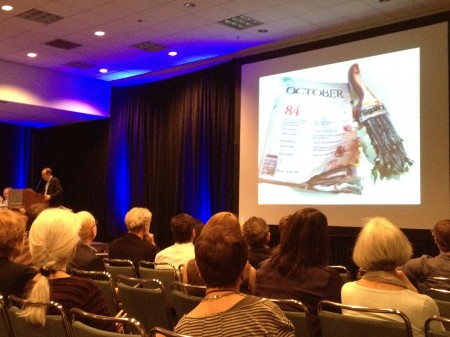The College Art Association celebrated its 100th year with more than 5,000 people gathered in downtown LA last Wednesday through Saturday for “the world’s best attended international art conference.” The city’s convention center buzzed with art talk, escalators, iPads, coffee shakes — most of our energy was sustained by the one Starbucks in a mile perimeter — and some stir-craziness at being in sunny 750 Los Angeles where the sessions better be good to keep us (notably the snowbirds) from hitting the beach.
That they were. One of the most exciting reasons to go to the CAA conference is for the new research and artist projects presented (several of which were beamed in by Skype this year). With topics including “Artists in Times of War and Revolution,” “Performance Evaluations,” “Information Visualization as a Research Method in Art History,” and “Mobile Spectatorship in Video/Film Installations,” the discussions and papers brought new insight to some of the programs and initiatives at the Walker involving crossing borders, performing arts/visual arts, online publishing, and audience engagement.
Some artist and curatorial work I’m still thinking about:
OtherIS. This online video database, curatorial platform, and news digest brings visibility to artists from U.S. sanctioned countries: Belarus, Burma, Cote d’Ivoire, Congo, Cuba, Iran, Iraq, Lebanon, North Korea, Somalia, Sudan, Syria, and Zimbabwe. It was presented by curator Sandra Skurvida in the session, “Artists in Times of War and Revolution” organized by the Association for Modern and Contemporary Art of the Arab World, Iran, and Turkey. Skurvida, insisting on the exemption of art exchanges from economic sanctions, discussed two OtherIs exhibitions/screenings she was involved with last year. TV/Dinner, a series of videos by artists working in the above-mentioned countries, launched at Tania Bruguera’s Immigrant Movement International (Queens, NY) and was then screened in NYC cafes and restaurants that served food from these places. For Iran via Video Current which opened at Thomas Erben Gallery (NY), New York-based Skurvida worked with Tehran-based curator Amirali Ghasemi to each program a selection of videos focusing on Iran, and through the process posed the issue of representation in transnational art production by critically considering the ways in which their projects intersected and diverged.
OMNI-ZonaFranca. A Cuban artist collective committed to engaging with communities in Havana through their work in performance, installation, sound, and poetry. They founded the National Rap Festival, a recurring poetry marathon—Poesia Sin Fin, and a “cosmic-lab” where they regularly meet to collaborate with other artists and activists. They’ve held weekly community nights where action poetry becomes a mechanism of healing, showed each others work in local art spaces, and have set up public interventions amidst people waiting in long lines at public places like bus stops and markets. Founded in the nineties, OMNI-ZonaFranca is one of the few groups in Cuba that have been able to sustain an artistic practice for so long, smartly navigating the law against what the state refers to as “social dangerousness.” In Coco Fusco’s wrap-up for the CAA session, “Breaking Laws in the Name of Art: New Perspectives on Contemporary Latin American Art,” she showed slides listing the kinds of art Cuba accepts and does not accept (for example, does: “evidence of material hardship in order to celebrate the ingenuity of Cubans in face of adversity,” and does not: “critiques of the internal security apparatus”). Despite the restrictions and arrests the OMNI group has dealt with, they continue to take risks with their work. Look forward to knowing more about them.
The experience of artists, art historians, curators, and graduate students coming together to share their work and ideas with each other, and exchange discussion in a critical space outside of our usual contexts (university, museum, gallery, media lab, or elsewhere), is certainly worth the yearly trip. Though I completely crashed on Sunday. For next time: nix the high heels, bring an insulated coffee container, and with the many super compelling presentations to choose from it’s essential to subdue that frantic tension between thoughts of “I’m constantly missing out” and “this could get really good” in order to get anything out of it. And to lay off Twitter to avoid being tempted by updates like “Someone is blasting Joan Jett’s ‘I love Rock and Roll’ in the next session room.”#CAA2012.


